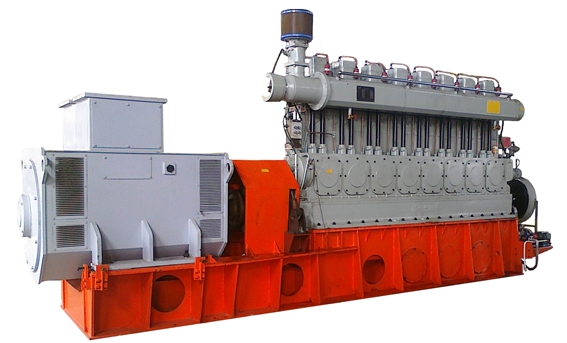沼氣脫硫是一種簡(jiǎn)單,成本相對(duì)較低的脫硫方法,也是一種應(yīng)用更為廣泛的脫硫方法。通過(guò)干式法從沼氣中除去硫化氫的設(shè)備的基本原理是O2將硫化氫(H2S)氧化為硫或硫氧化物的方法,也可以稱為干氧化法。填充物放置在內(nèi)部,填充層包括活性炭,氧化鐵等。如今,氧化鐵更為常用。氣體以低流速?gòu)囊欢说娜肟谶M(jìn)入容器,穿過(guò)容器中的填料層,硫化氫(H2S)被氧化成硫或硫氧化合物,并保留在填料層中。凈化后的氣體從容器另一端的出氣口排出。
Biogas desulfurization is not only a simple and relatively low-cost desulfurization method, but also a more widely used desulfurization method. The basic principle of the equipment for removing hydrogen sulfide from biogas by dry method is the method that O2 oxidizes hydrogen sulfide (H2S) into sulfur or thiooxide, which can also be called dry oxidation method. The filler is placed inside, and the filler layer includes activated carbon, iron oxide, etc. Nowadays, iron oxide is more commonly used. The gas enters the container from the inlet at one end at a low flow rate and passes through the packing layer in the container. Hydrogen sulfide (H2S) is oxidized into sulfur or sulfur oxide compounds and retained in the packing layer. The purified gas is discharged from the air outlet at the other end of the container.
沼氣脫硫的運(yùn)行和維護(hù)應(yīng)符合下列要求:
The operation and maintenance of biogas desulfurization shall meet the following requirements:
1、脫水脫硫裝置中的冷凝水應(yīng)定期排放。當(dāng)室外溫度接近0°C時(shí),應(yīng)每天排放冷凝水,并在排放時(shí)防止沼氣泄漏。
1. The condensate in the dehydration and desulfurization unit shall be discharged regularly. When the outdoor temperature is close to 0 ° C, the condensate shall be discharged every day and the biogas leakage shall be prevented during discharge.
2、生物脫硫開(kāi)始并正常進(jìn)行后,應(yīng)定期檢查脫硫前后的硫化氫濃度變化,并且硫化氫的去除率應(yīng)符合后端工藝的要求。當(dāng)發(fā)現(xiàn)脫硫效率大大降低時(shí),應(yīng)及時(shí)補(bǔ)充循環(huán)的營(yíng)養(yǎng)液。塔中的填料應(yīng)每6-12個(gè)月清潔一次。
2. After biological desulfurization is started and carried out normally, the change of hydrogen sulfide concentration before and after desulfurization shall be checked regularly, and the removal rate of hydrogen sulfide shall meet the requirements of back-end process. When the desulfurization efficiency is greatly reduced, the circulating nutrient solution shall be supplemented in time. The packing in the tower shall be cleaned every 6-12 months.
3、應(yīng)當(dāng)定期檢查干燥脫硫塔前后的硫化氫濃度和沼氣壓力變化。當(dāng)不滿足設(shè)計(jì)要求時(shí),應(yīng)更換脫硫劑或進(jìn)行脫硫再生。
3. The changes of hydrogen sulfide concentration and biogas pressure before and after drying the desulfurization tower shall be checked regularly. When the design requirements are not met, the desulfurizer shall be replaced or desulfurization regeneration shall be carried out.
4、干式脫硫塔的再生應(yīng)滿足以下要求:
4. The regeneration of dry desulfurization tower shall meet the following requirements:
1)在塔內(nèi)使用脫硫劑進(jìn)行再生時(shí),應(yīng)關(guān)閉沼氣的進(jìn),出口閥門,并旁路支管和排放閥門管道應(yīng)打開(kāi)。
1) When desulfurizer is used for regeneration in the tower, the inlet and outlet valves of biogas shall be closed, and the bypass branch pipe and discharge valve pipeline shall be opened.
2)當(dāng)使用在線脫硫器再生時(shí),應(yīng)根據(jù)沼氣中的硫化氫含量確定空氣混合量和空氣流速,塔內(nèi)溫度應(yīng)低于70℃,且塔內(nèi)的氧含量脫硫塔出口沼氣應(yīng)小于1%;
2) When the on-line desulfurizer is used for regeneration, the air mixing amount and air flow rate shall be determined according to the hydrogen sulfide content in the biogas. The temperature in the tower shall be lower than 70 ℃, and the oxygen content in the tower shall be less than 1% of the biogas at the outlet of the desulfurization tower;
3)脫硫劑應(yīng)在2?3次再生后及時(shí)更換。更換脫硫劑時(shí),操作員應(yīng)戴防毒面具,房間應(yīng)通風(fēng)。
3) The desulfurizer shall be replaced in time after 2 ~ 3 times of regeneration. When replacing desulfurizer, the operator shall wear gas mask and the room shall be ventilated.
4)沼氣脫硫廢脫硫器的處置應(yīng)符合環(huán)境保護(hù)要求。
4) The disposal of biogas desulfurization waste desulfurizer shall meet the requirements of environmental protection.
